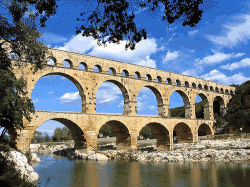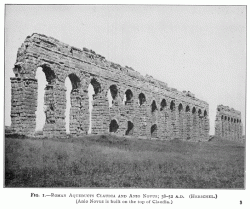ROMAN AQUEDUCTS
Roman Aqueduct

There were 11 major aqueducts in Rome. They were built between 312 B.C. and 226 A.D. The depth of the channel below ground varied to maintain a constant, and very shallow gradient through the length of the aqueduct. The columns were built for ventilation and access.
Anio Novus

This Aqueduct was the longest. It was 59 miles long. While the towns population was well over 1 million, the aqueduct provided 1 cubic meter of water a day. This is more than we are used to these days. It lead water to the most number of cities any other aqueduct did (200 cities).
Aqua Appia
Aqua Appia was built in 312 B.C during the Roman Republic. It was built in conjunction with the road named Via Appia. It was built by Appius Claudius Caecus. It is known as the oldest aqueduct in Ancient Rome. It is 16 kilometers long and runs 18 miles to the Sabine Hills outside Rome. They say that it is the lowest underground aqueduct. They designed it so the structure is much like Greek and Egyptian Aqueducts.
Aqua Alexandrina

This aqueduct was constructed by Alexander Severus. It was built in 226 A.D. It was the last aqueduct built and was 14 miles long.
Facts on Aqueducts
It is called the great and highly advanced waterway system. They were built out of a combination of stone, brick and special volcanic cement pozzuolana. The waterway was mostly underground but the visible parts left a definite impression. Out of 260 miles of aqueducts in Rome only 30 miles of this were visible to humans the rest was underground. Once the water reached Rome it was stored in huge cisterns. These held enormous amounts of water for the city it was given to. How individual areas got water is because of individual lead pipes leading from the cisterns. The Romans assigned people to work (curators) and keep them running smoothly.



